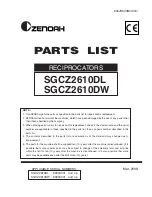
HELPLINE NO 08454 505299
5
ORIGINAL INSTRUCTIONS
Use extra caution when making
a “plunge cut” into existing walls
or other blind areas.
The protruding
blade may cut objects that can cause
kickback.
Check lower guard for proper
closing before each use. Do not
operate the saw if lower guard
does not move freely and close
instantly. Never clamp or tie the
lower guard into the open position.
If saw is accidentally ropped, lower guard
may be bent. Raise the lower guard with the
retracting handle and make sure it moves
freely and does not touch the blade or any
other part, in all angles and depths of cut.
Check the operation of the lower
guard spring. If the guard and the
spring are not operating properly,
they must be serviced before use
.
Lower guard may operate sluggishly due to
damaged parts, gummy deposits, or a
build-up of debris.
Lower guard should be retracted
manually only for special cuts such
as “plunge cuts” and “compound
cuts”. Raise lower guard by
retracting handle and as soon as
blade enters the material, the lower
guard must be released
. For all other
sawing, the lower guard should operate
automatically.
Always observe that the lower
guard is covering the blade before
placing saw down on bench or floor.
An unprotected, coasting blade will cause the
saw to walk backwards, cutting whatever is in
its path. Be aware of the time it takes for the
blade to stop after switch is released.
Do not reach into the saw dust ejector
with your hands.
They could be injured by
rotating parts.
Do not work overhead with the saw.
In this manner you do not have sufficient control
over the power tool.
Use suitable detectors to determine
if utility lines are hidden in the work
area or call the local utility company
for assistance.
Contact with electric lines
can lead to fire and electric shock. Damaging
a gas line can lead to explosion. Penetrating a
water line causes property damage or may
cause an electric shock.
Do not operate the power tool
stationary.
It is not designed for operation
with a saw table.
Do not use high speed steel (HSS)
saw blades.
Such saw blades can easily
break.
Do not saw ferrous metals
. Red hot chips
can ignite the dust extraction.
When working with the machine,
always hold it firmly with both hands
and provide for a secure stance.
The
power tool is guided more secure with both
hands.
Secure the workpiece
. A workpiece
clamped with clamping devices or in a vice is
held more secure than by hand.
Always wait until the machine has
come to a complete stop before
placing it down.
The tool insert can jam and
lead to loss of control over the power tool.
Never use the machine with a
damaged cable. Do not touch the
damaged cable and pull the mains
plug when the cable is damaged
while working.
Damaged cables increase
the risk of an electric shock.
SAFETY WARNING FOR
YOUR LASER
The laser device fitted to this tool is class 1
with a maximum radiation of 1mW and
650nm wavelength. These lasers do not
normally present an optical hazard although
staring at the beam may cause flash blindness.
Do not stare directly at the laser beam.
A
hazard may exist if you deliberately
stare into the beam, please observe
•
•
•
•
•
•
•
•
•
•
•
•
•
•
•
































